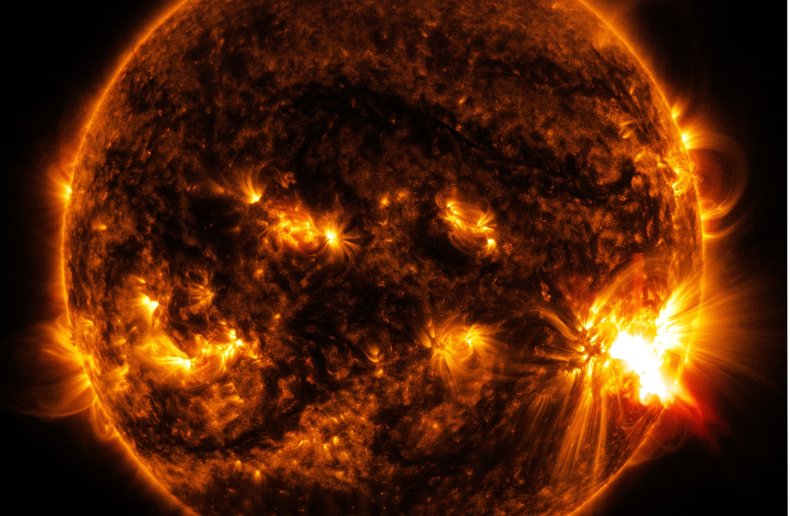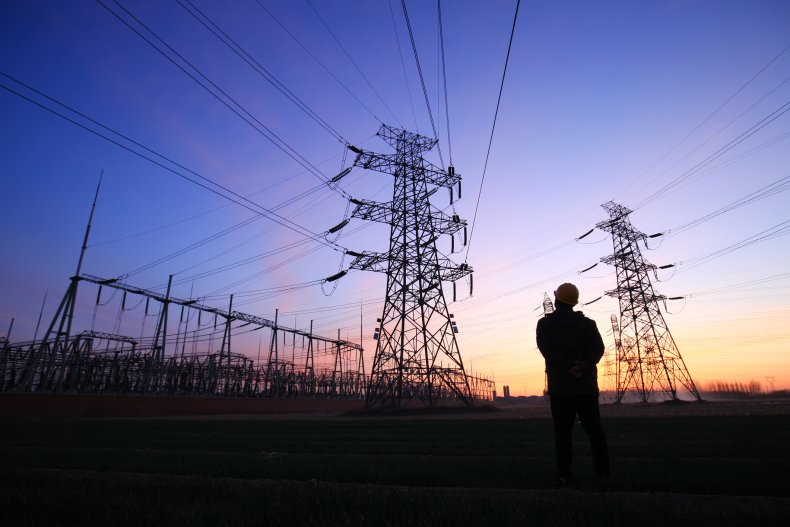BY ED BROWNE ON 7/1/22 AT 12:09 PM EDTPauseUnmute
Watch Giant Solar Flare 19 Times Bigger Than Earth Erupt From Sun’s Surface
SHARE
TECH & SCIENCESCIENCESPACESPACE WEATHERSOLAR FLARE
On September 1, 1859, British astronomer Richard Carrington was observing the sun through a specially designed telescope fitted with protective filters. At one point, he saw a flash of white light from a dark area of the sun known as a sunspot.
Within a day, people started to notice strange things happening. The night sky was lit up with brilliantly colorful auroras, so bright that people were reportedly able to read newspapers at night by their light alone.
Elsewhere, telegraph operators noted that their communication lines were suddenly useless, and some operators in France even reported that sparks flew when they interrupted a circuit of conducting wire.
What these people were experiencing was a geomagnetic storm now known as the Carrington Event, and it’s believed to have been the most intense of its kind in recorded history.

Geomagnetic storms are disturbances in Earth’s magnetic field caused by powerful eruptions of material from the sun called coronal mass ejections (CMEs). They are related to solar flares, powerful flashes of light and other radiation, that often precede CMEs.
These eruptions occur as part of the solar cycle, a roughly 11-year period in which the sun’s activity rises and falls. The sun is currently winding up to the peak of its current cycle, meaning that for the next few years we can expect the number of flares and CMEs to increase.
We now know that flares and CMEs occur regularly and can affect radio communications, navigation systems and electrical grids. This wasn’t so much of a problem in 1859, but in today’s tech-heavy society, what would a Carrington Event-level storm look like, and how would we cope?
NEWSWEEK SUBSCRIPTION OFFERS >
Scientists think we barely escaped getting hit by one such huge storm that erupted from the sun in July 2012 that was at least as strong as the Carrington Event and could have cost over $2 trillion in damage. “The only difference is, it missed,” Daniel Baker, a space weather researcher at the University of Colorado, said a couple of years later.
Exact estimates on how often such storms might hit Earth are difficult to make. One U.S. National Oceanic and Atmospheric Administration (NOAA) estimate puts the rate at about once per 500 years, but it could be less. One thing’s for sure: The question is not if it happens again, but when.
It Starts With a Flash
The initial flare bathes our planet in radiation including X-rays. These interact with the ionosphere, a layer of Earth’s atmosphere containing ions and electrons that is able to reflect radio waves.
“A lot of our communications with aircraft or over remote areas still use high-frequency comms using what we call a skywave—bouncing a signal off the ionosphere,” Bill Murtagh, program co-ordinator at the U.S. National Oceanic and Atmospheric Administration Space Weather Prediction Center (SWPC), told Newsweek. “During the solar flare phase of an eruption, the ionosphere characteristics change to such a degree that that signal won’t bounce. So within seconds of the flare erupting, we lose the capability to communicate via that mode.
“Sometimes we also get radio waves that will interfere with some of our satellite receivers, including GPS. When this happens, it kind of saturates the receiver if everything’s lined up right, and causes some problems for our satellite communication capability.”
Then there are CMEs, which tend to follow after flares. CMEs are essentially clouds of charged solar particles and magnetic fields that erupt from the sun’s atmosphere. “The sun has essentially shot a magnet out into space,” Murtagh said. “That magnet sometimes comes right towards Earth, and Earth also has magnetic fields.”

“Now we’ve got the Faraday laws; we’ve got magnets coupling together, inducing currents, and those currents will manifest themselves on the ground. That’s why it’s so important in our work here in the United States to determine the geology of the ground beneath us to determine the vulnerability to our power grid assets to this current that has been introduced… now we’ve introduced a DC current into an AC network, and that is not a good day.”
Modern Solutions
While the world today has many assets that are highly susceptible to the whims of the sun, we’ve also developed clever ways of protecting them.
Flares are difficult since they travel at the speed of light. By the time we’ve observed them, their effect on the atmosphere has already begun. Here, it’s a matter of contacting relevant industries to let them know what’s going on if a solar flare occurs.
“That information we’d immediately send to, for example, the air traffic communication center in Long Island, co-ordinating with aircraft out over the Atlantic,” Murtagh said. “They need to know immediately what’s causing that communication problem.”
This is particularly relevant for countries that regularly manage flights over polar areas, since these regions tend to be particularly badly affected. Those flights might have to be re-routed, and altitudes can also be changed during solar storms.
READ MORE
- Watch Giant Solar Flare 19 Times Bigger Than Earth Erupt From Sun’s Surface
- ‘Unusual’ Solar Storm Recorded on Surface of Sun by Astronomy Photographer
- How Does the Sun Affect Space Weather?
Regarding the power grid, space weather experts would make a hotline call to the North American Electric Reliability Corporation, passing information on the storm over to them, which is then distributed to power entities around the country. It’s then up to them to decide how they will handle potential power surges in their lines.
“They start taking action immediately,” said Murtagh. “Some grids could be out for maintenance, and that’s actually counter-intuitive. You don’t want them out, you want to be in a robust state with everything working so you can manage the unwanted currents—so they’ll postpone maintenance activities. That can make all the difference.”
A Doomsday Scenario?
While the world today is certainly more susceptible to damage from a solar flare than it was in 1859, most regular people never even know that a solar storm is happening. Partly this is because we have the technology to manage them, but also it’s because seriously strong flares are so rare.
It raises the question: What would happen if a Carrington-level storm occurred today?
Insurance company Lloyds of London investigated this very question and produced a report on the matter in 2013.
“In the more extreme end of the spectrum, a major space weather event on the scale of the Carrington Event could lead to power loss for a period of weeks or more,” one section reads.
“This would cause major disruption to transport, food supplies, emergency and hospital services amongst other things. For example, if pumping operations needed to be suspended that would quickly affect water and fuel supplies, sewage systems and flood defences. The absence of such fundamental services could lead to major and widespread social unrest, riots and theft with ramifications for the insurance industry and society in general.”
One good reference point to use is the Halloween period of 2003, when over the course of a few weeks, the sun suddenly released a barrage of eruptions including one flare that was one of the largest ever recorded by satellite.
A U.S. government report shows that the impacts were wide-ranging. In northern Europe, current caused transformer problems and a blackout; NASA told ISS astronauts to take shelter due to radiation; aircraft were rerouted at a cost of up to $100,000 per flight; nearly 60 percent of NASA science missions experienced anomalies; and the storm was suspected as a possible cause of the failure of the $640 million ADEOS-2 spacecraft.
Separate analysis showed a dozen grid transformers in South Africa were so damaged that they had to be removed from service.
Impact on Consumer Electronics
Another question is whether a solar storm could cause such intense charges that it affects everyday consumer electronics?
“No, we don’t think so,” said Murtagh. “It does require that larger grid for that current to get up into the ground and flow through, so it won’t affect your computers.”
“The doomsday scenario we fear is that it affects the grid to such a degree that we lose large parts of the grid for a long period of time,” he concluded. “Any time there’s an outage that goes into hours, the impact is quickly measured in billions of dollars [of cost].”
